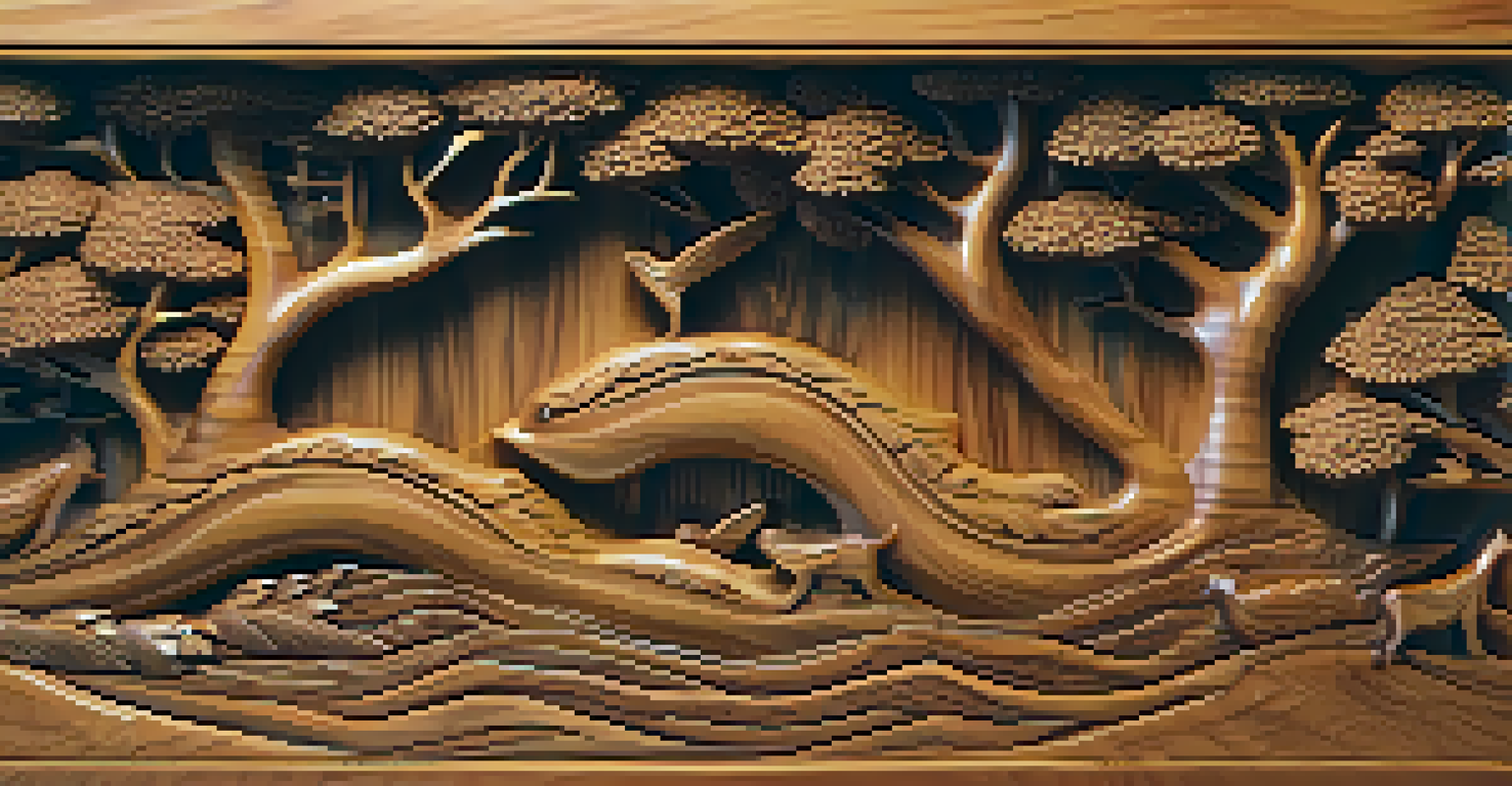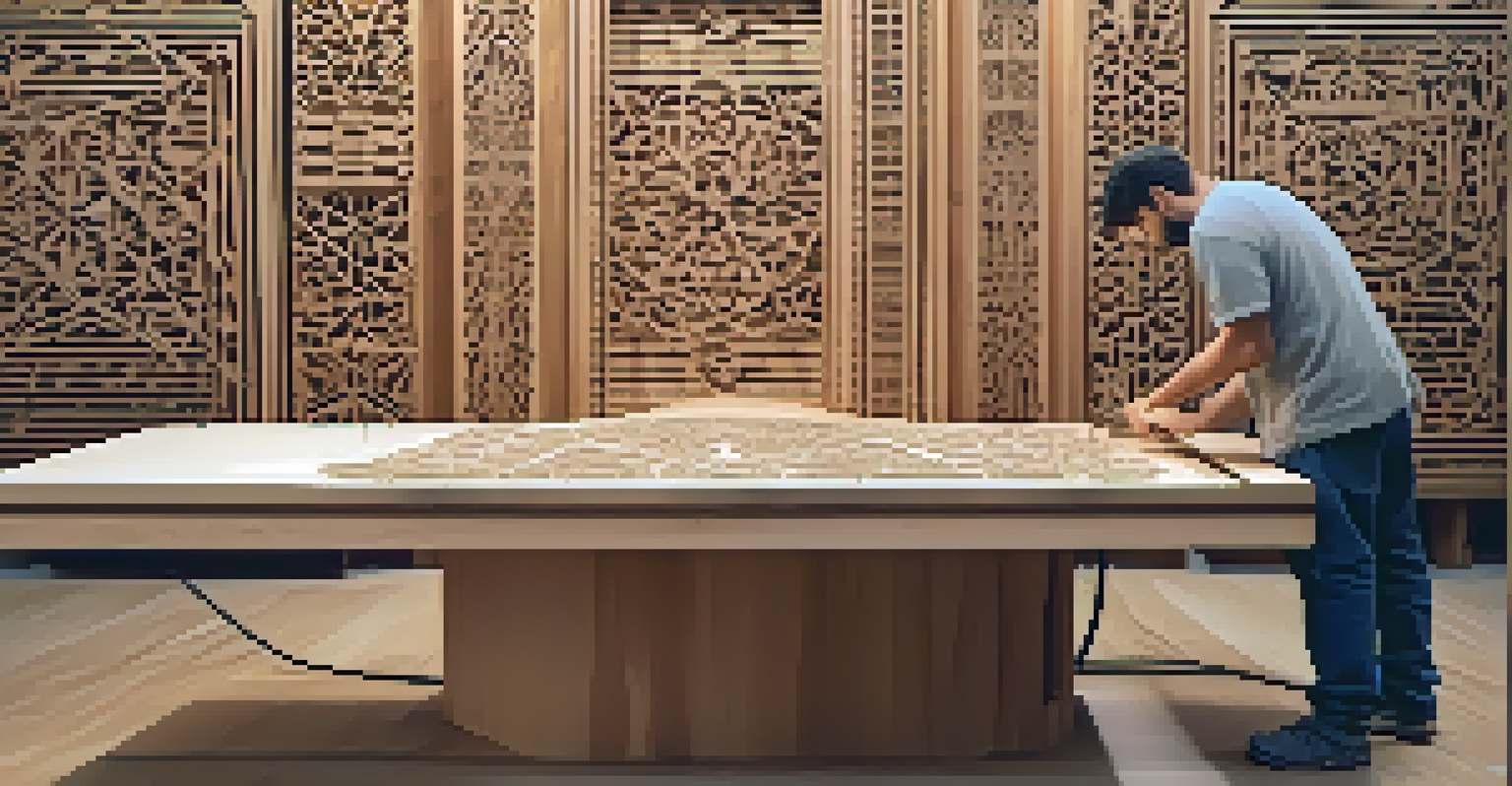Exploring the Origins of Stone and Wood Carving Techniques

The Ancient Beginnings of Stone Carving
Stone carving dates back to prehistoric times, where early humans used simple tools to create functional objects and art. These first carvings were often found in caves and were essential for survival, serving as tools or weapons. As societies advanced, the techniques became more sophisticated, with artisans developing unique styles that reflected their culture.
Every artist dips his brush in his own soul, and paints his own nature into his pictures.
The use of stone for decorative purposes began with ancient civilizations, such as the Egyptians and Greeks, who crafted intricate sculptures and monumental architecture. They employed chisels and hammers made from harder stones to achieve precise details, showcasing their engineering prowess. This ability to manipulate stone not only served aesthetic purposes but also conveyed power and religious significance.
Today, we can trace the evolution of stone carving through various historical periods, from the grandeur of Roman sculptures to the delicate work of Renaissance artists. Each era brought innovation, influencing modern techniques that continue to inspire artists worldwide. Understanding these origins helps us appreciate the skill and creativity involved in stone carving.
Wood Carving: A Tradition Rooted in Nature
Wood carving has a long-standing tradition, deeply connected to the availability of timber and the cultures that thrived alongside forests. Early woodworkers utilized basic tools, such as knives and axes, to create everyday objects like utensils, furniture, and decorative pieces. The tactile nature of wood allowed for a variety of techniques that highlighted its natural beauty.

As societies evolved, so did the complexity of wood carving. Craftsmen began to experiment with different types of wood and intricate designs, leading to the development of styles like relief carving and whittling. This art form not only served practical purposes but also became an expression of cultural identity, with distinct regional styles emerging across the globe.
Carving's Rich Cultural Heritage
Stone and wood carving techniques reflect the cultural identities and spiritual beliefs of various societies throughout history.
Today, wood carving remains a vibrant craft, blending traditional methods with contemporary techniques. Modern artisans often incorporate technology, such as CNC machines, while still honoring the time-honored practices of their predecessors. This fusion of old and new continues to inspire woodworkers and enthusiasts alike.
Tools of the Trade: Essential Equipment for Carvers
Both stone and wood carving require specific tools, each designed for different purposes. For stone carvers, tools like chisels, hammers, and drills are fundamental in shaping and detailing their work. The choice of tool can significantly impact the final product, influencing the texture and precision of the carvings.
The sculptor's greatest tool is his own mind.
Wood carvers, on the other hand, rely on a diverse range of tools, from whittling knives to specialized chisels. Each tool allows for different techniques—some are perfect for creating fine details, while others are better suited for larger, broader strokes. Understanding the function of these tools is essential for any aspiring carver.
Moreover, the evolution of tools over time has allowed artists to push the boundaries of their craft. Modern advancements have introduced new materials and technologies, making it easier for craftsmen to achieve intricate designs that were once nearly impossible. This evolution reflects the ongoing journey of both stone and wood carving techniques.
Cultural Significance of Carving in Different Societies
Carving techniques are often deeply intertwined with the cultural identity of a society. For instance, in many Indigenous cultures, wood and stone carvings serve spiritual purposes, telling stories of creation and ancestral lineage. These carvings often reflect the values and beliefs of the community, acting as a visual narrative for future generations.
In contrast, ancient civilizations like the Egyptians utilized stone carvings to immortalize their rulers and deities, showcasing their power through monumental sculptures. These creations were not just art; they were integral to the civilization's religion and governance, illustrating the profound connection between art and society.
Evolution of Carving Techniques
Both stone and wood carving have evolved significantly, blending traditional methods with modern innovations to enhance creativity and precision.
Today, many cultures continue to uphold their carving traditions, passing them down through generations. This preservation of techniques not only honors the past but also fosters a sense of belonging and continuity within communities. Understanding the cultural significance of carving enriches our appreciation for this timeless art form.
Techniques that Define Stone Carving Artistry
Stone carving encompasses a variety of techniques that artists employ to achieve different effects and finishes. One of the most common methods is direct carving, where the artist works directly on the stone, removing material to reveal the desired shape. This hands-on approach allows for a personal touch and unique expression in each piece.
Another technique is relief carving, where the design projects from the background, creating a three-dimensional effect. This method has been widely used in architectural elements, such as friezes and cornices, adding depth and detail to buildings. Each technique requires a keen eye and a steady hand, making mastery a significant accomplishment for any stone carver.
In contemporary practices, artists often combine traditional techniques with modern innovations, such as 3D modeling software. This blending of old and new expands the possibilities of stone carving, allowing for the creation of intricate designs that were once unimaginable. As techniques evolve, so does the artistry behind them, continually pushing the boundaries of creativity.
Exploring Wood Carving Techniques: From Whittling to Relief
Wood carving techniques vary greatly, each offering a different approach to working with this versatile material. Whittling, for example, is a popular technique that involves carving small pieces of wood using a knife. This method is often seen as a meditative practice, allowing the carver to connect with their material while creating intricate designs.
Relief carving is another prevalent technique, where the design is carved into the surface of the wood, creating a raised effect. This method is commonly used in decorative panels and furniture, adding visual interest and depth. The intricacies of relief carving require patience and skill, making it a favorite among seasoned artisans.
Sustainability in Modern Carving
Today's artists are increasingly focused on sustainability, choosing eco-friendly materials and responsible sourcing to benefit the environment.
As wood carving continues to evolve, modern techniques like chip carving and power carving are gaining popularity. These methods allow for precision and intricate detailing, enabling artists to create stunning works of art. By exploring various techniques, carvers can find their unique style and express their creativity in exciting new ways.
The Future of Carving: Innovations and Sustainability
As we look to the future, the world of carving is witnessing exciting innovations that are reshaping the craft. Digital tools and software have emerged, allowing artists to design and plan their work with precision before touching the material. This technology opens new doors for creativity, enabling carvers to explore complex designs with ease.
Sustainability is also becoming increasingly important in both stone and wood carving. Artists are now more conscious of their material choices, seeking eco-friendly options and sourcing wood from responsibly managed forests. This shift not only benefits the environment but also adds value to the artwork, as consumers become more aware of the origins of the materials they purchase.

Ultimately, the future of carving lies in balancing tradition with innovation. As new techniques and technologies emerge, the essence of carving—creativity and expression—will continue to thrive. By embracing both the old and the new, artists can ensure that this timeless craft remains relevant for generations to come.